Marketing Practices in Hospitality Industry - HNC/HND Report
VerifiedAdded on 2023/01/23
|21
|5034
|50
Report
AI Summary
This report provides a comprehensive analysis of marketing practices within the hospitality industry, focusing on the case of Marriott International. The report is structured into three key learning outcomes (LOs). LO1 explores the role of marketing, its interrelation with other functional units, and examines current and future trends within Marriott International. It also includes an overview of marketing processes and the responsibilities of a marketing manager. LO2 delves into the 7Ps marketing mix, illustrating how these elements are utilized to achieve business objectives. LO3 outlines the development of a basic marketing plan, complete with tactics, action plans, and methods for monitoring and evaluating progress to meet overall marketing objectives. The report includes detailed examples and references to support the analysis, offering insights into the practical application of marketing principles in the hospitality sector. The assignment adheres to the Harvard Referencing System.
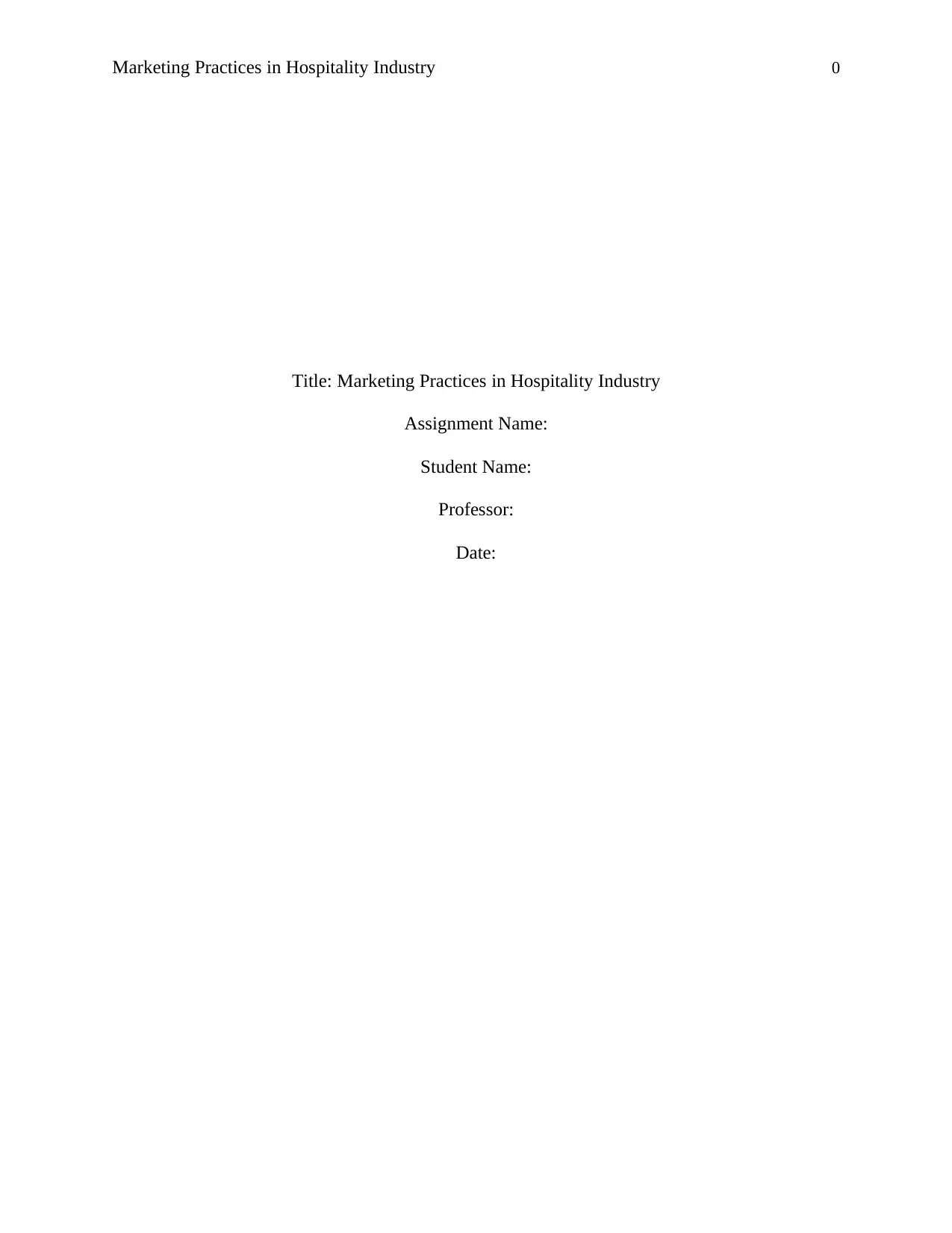
Marketing Practices in Hospitality Industry 0
Title: Marketing Practices in Hospitality Industry
Assignment Name:
Student Name:
Professor:
Date:
Title: Marketing Practices in Hospitality Industry
Assignment Name:
Student Name:
Professor:
Date:
Paraphrase This Document
Need a fresh take? Get an instant paraphrase of this document with our AI Paraphraser
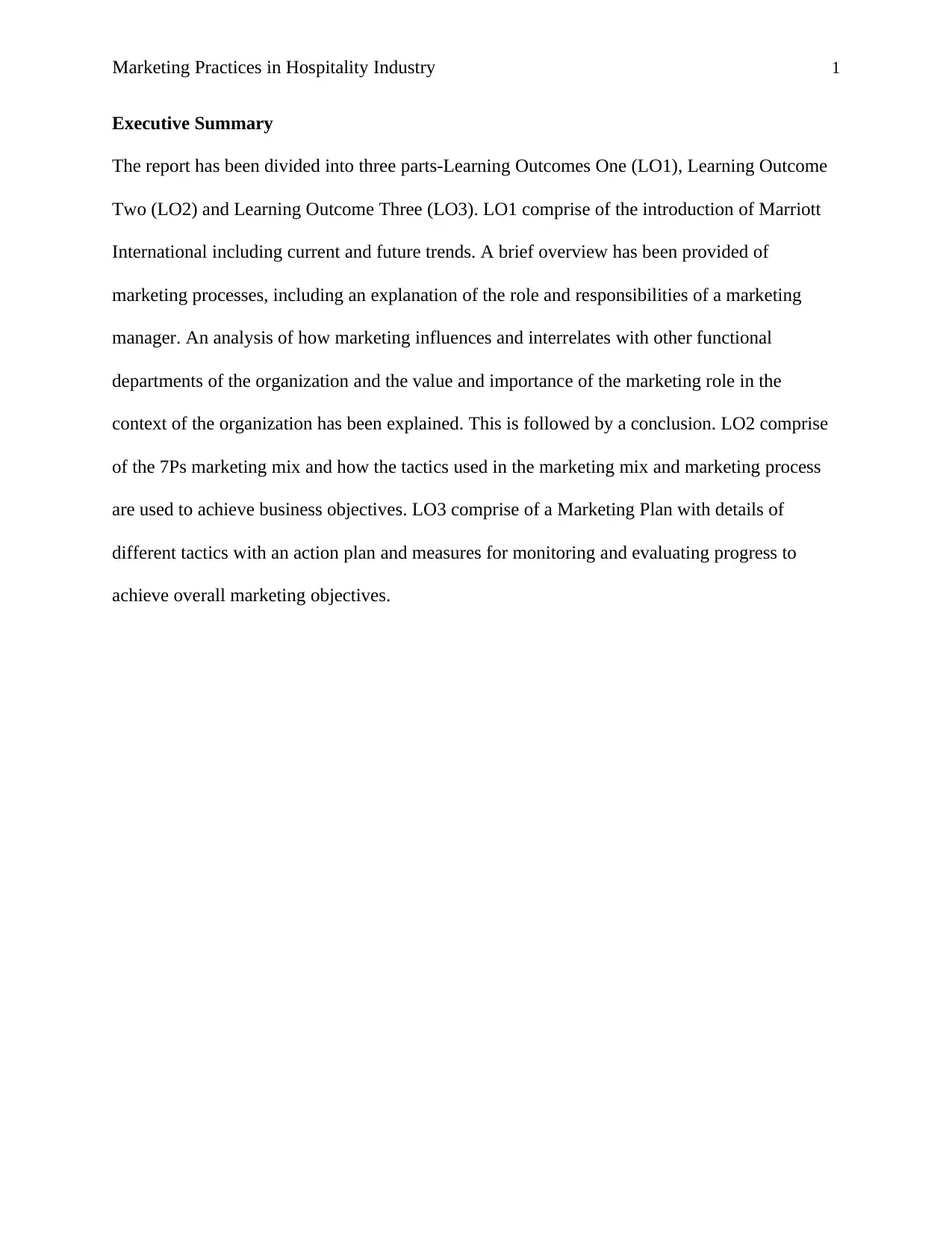
Marketing Practices in Hospitality Industry 1
Executive Summary
The report has been divided into three parts-Learning Outcomes One (LO1), Learning Outcome
Two (LO2) and Learning Outcome Three (LO3). LO1 comprise of the introduction of Marriott
International including current and future trends. A brief overview has been provided of
marketing processes, including an explanation of the role and responsibilities of a marketing
manager. An analysis of how marketing influences and interrelates with other functional
departments of the organization and the value and importance of the marketing role in the
context of the organization has been explained. This is followed by a conclusion. LO2 comprise
of the 7Ps marketing mix and how the tactics used in the marketing mix and marketing process
are used to achieve business objectives. LO3 comprise of a Marketing Plan with details of
different tactics with an action plan and measures for monitoring and evaluating progress to
achieve overall marketing objectives.
Executive Summary
The report has been divided into three parts-Learning Outcomes One (LO1), Learning Outcome
Two (LO2) and Learning Outcome Three (LO3). LO1 comprise of the introduction of Marriott
International including current and future trends. A brief overview has been provided of
marketing processes, including an explanation of the role and responsibilities of a marketing
manager. An analysis of how marketing influences and interrelates with other functional
departments of the organization and the value and importance of the marketing role in the
context of the organization has been explained. This is followed by a conclusion. LO2 comprise
of the 7Ps marketing mix and how the tactics used in the marketing mix and marketing process
are used to achieve business objectives. LO3 comprise of a Marketing Plan with details of
different tactics with an action plan and measures for monitoring and evaluating progress to
achieve overall marketing objectives.
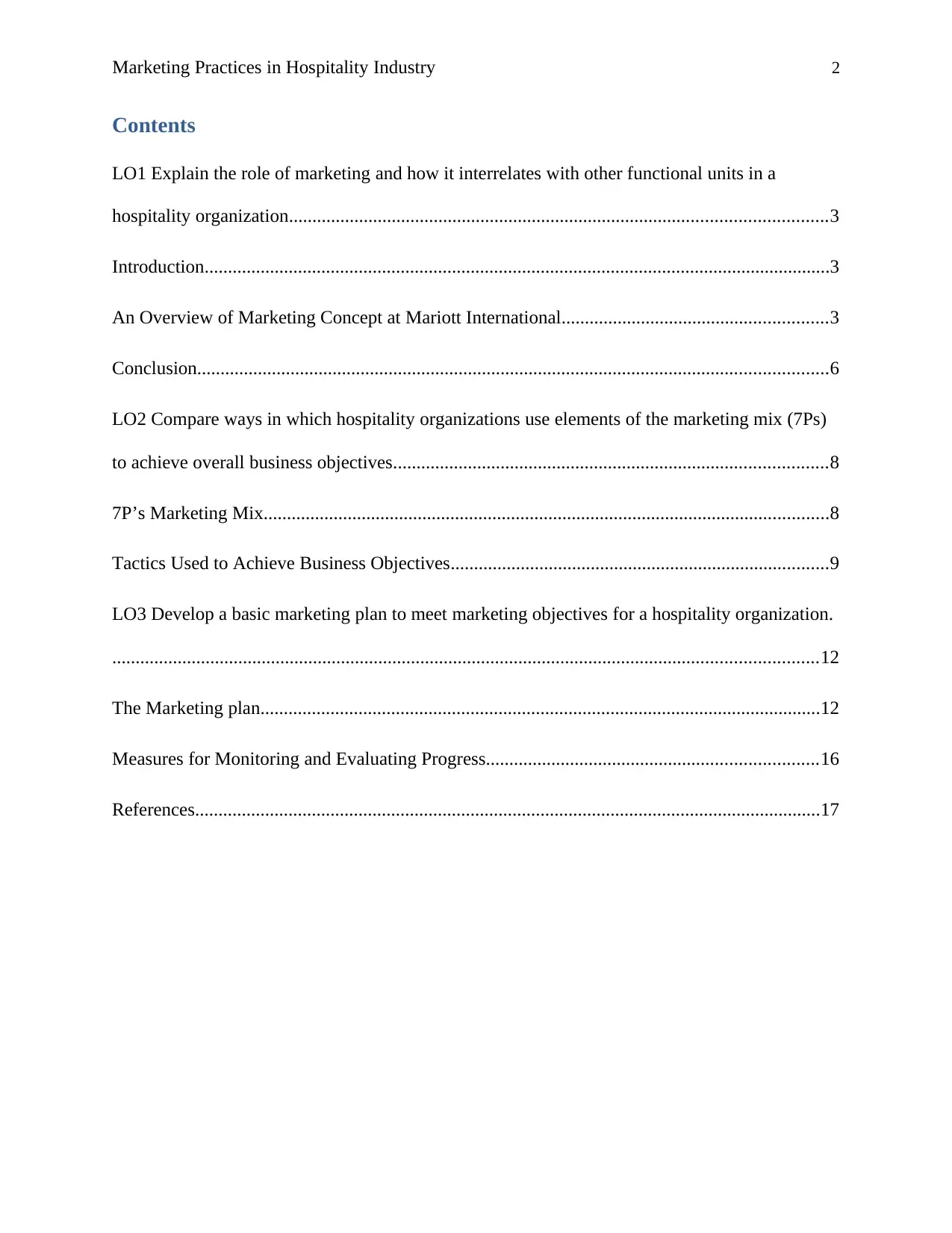
Marketing Practices in Hospitality Industry 2
Contents
LO1 Explain the role of marketing and how it interrelates with other functional units in a
hospitality organization...................................................................................................................3
Introduction......................................................................................................................................3
An Overview of Marketing Concept at Mariott International.........................................................3
Conclusion.......................................................................................................................................6
LO2 Compare ways in which hospitality organizations use elements of the marketing mix (7Ps)
to achieve overall business objectives.............................................................................................8
7P’s Marketing Mix.........................................................................................................................8
Tactics Used to Achieve Business Objectives.................................................................................9
LO3 Develop a basic marketing plan to meet marketing objectives for a hospitality organization.
.......................................................................................................................................................12
The Marketing plan........................................................................................................................12
Measures for Monitoring and Evaluating Progress.......................................................................16
References......................................................................................................................................17
Contents
LO1 Explain the role of marketing and how it interrelates with other functional units in a
hospitality organization...................................................................................................................3
Introduction......................................................................................................................................3
An Overview of Marketing Concept at Mariott International.........................................................3
Conclusion.......................................................................................................................................6
LO2 Compare ways in which hospitality organizations use elements of the marketing mix (7Ps)
to achieve overall business objectives.............................................................................................8
7P’s Marketing Mix.........................................................................................................................8
Tactics Used to Achieve Business Objectives.................................................................................9
LO3 Develop a basic marketing plan to meet marketing objectives for a hospitality organization.
.......................................................................................................................................................12
The Marketing plan........................................................................................................................12
Measures for Monitoring and Evaluating Progress.......................................................................16
References......................................................................................................................................17
⊘ This is a preview!⊘
Do you want full access?
Subscribe today to unlock all pages.

Trusted by 1+ million students worldwide
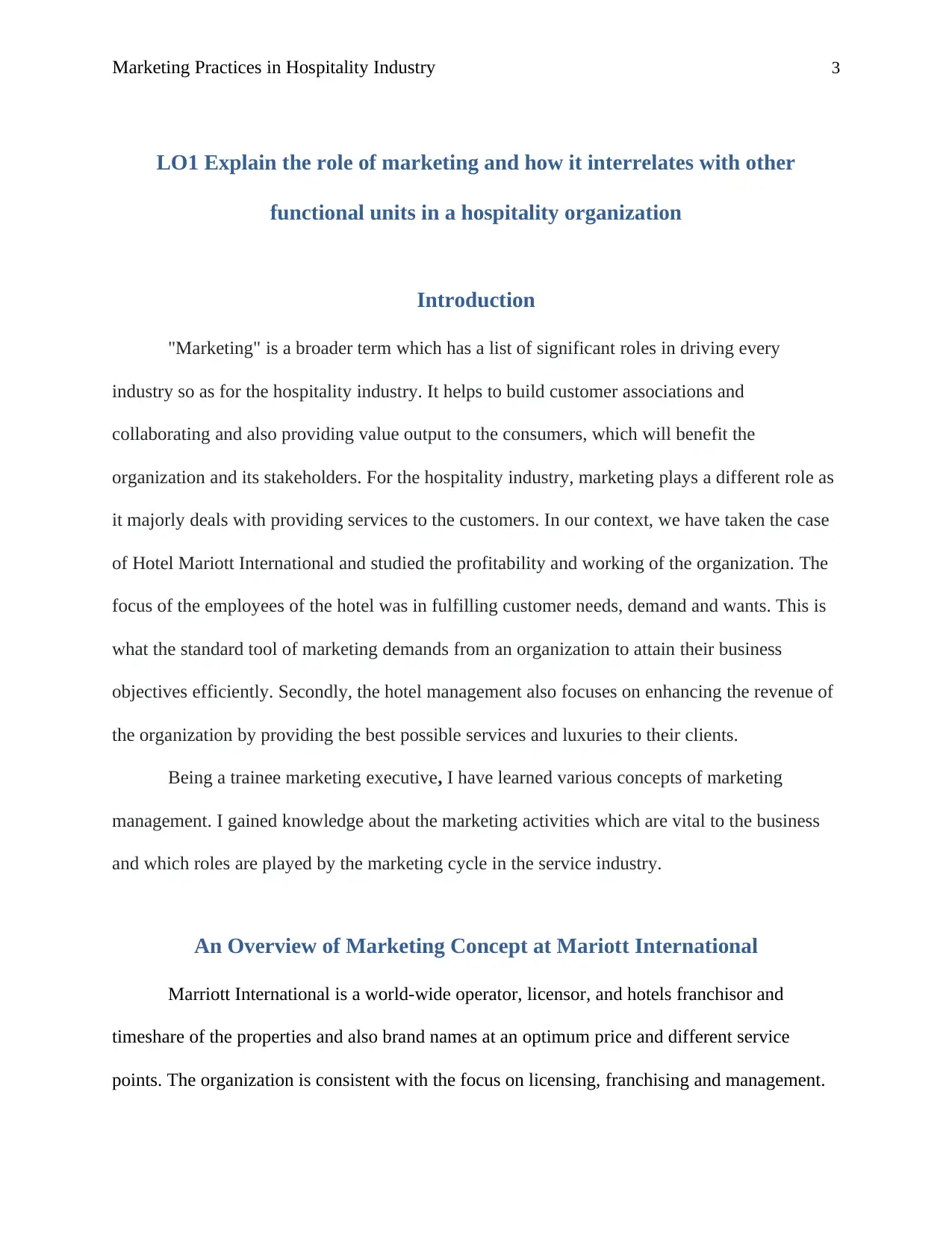
Marketing Practices in Hospitality Industry 3
LO1 Explain the role of marketing and how it interrelates with other
functional units in a hospitality organization
Introduction
"Marketing" is a broader term which has a list of significant roles in driving every
industry so as for the hospitality industry. It helps to build customer associations and
collaborating and also providing value output to the consumers, which will benefit the
organization and its stakeholders. For the hospitality industry, marketing plays a different role as
it majorly deals with providing services to the customers. In our context, we have taken the case
of Hotel Mariott International and studied the profitability and working of the organization. The
focus of the employees of the hotel was in fulfilling customer needs, demand and wants. This is
what the standard tool of marketing demands from an organization to attain their business
objectives efficiently. Secondly, the hotel management also focuses on enhancing the revenue of
the organization by providing the best possible services and luxuries to their clients.
Being a trainee marketing executive, I have learned various concepts of marketing
management. I gained knowledge about the marketing activities which are vital to the business
and which roles are played by the marketing cycle in the service industry.
An Overview of Marketing Concept at Mariott International
Marriott International is a world-wide operator, licensor, and hotels franchisor and
timeshare of the properties and also brand names at an optimum price and different service
points. The organization is consistent with the focus on licensing, franchising and management.
LO1 Explain the role of marketing and how it interrelates with other
functional units in a hospitality organization
Introduction
"Marketing" is a broader term which has a list of significant roles in driving every
industry so as for the hospitality industry. It helps to build customer associations and
collaborating and also providing value output to the consumers, which will benefit the
organization and its stakeholders. For the hospitality industry, marketing plays a different role as
it majorly deals with providing services to the customers. In our context, we have taken the case
of Hotel Mariott International and studied the profitability and working of the organization. The
focus of the employees of the hotel was in fulfilling customer needs, demand and wants. This is
what the standard tool of marketing demands from an organization to attain their business
objectives efficiently. Secondly, the hotel management also focuses on enhancing the revenue of
the organization by providing the best possible services and luxuries to their clients.
Being a trainee marketing executive, I have learned various concepts of marketing
management. I gained knowledge about the marketing activities which are vital to the business
and which roles are played by the marketing cycle in the service industry.
An Overview of Marketing Concept at Mariott International
Marriott International is a world-wide operator, licensor, and hotels franchisor and
timeshare of the properties and also brand names at an optimum price and different service
points. The organization is consistent with the focus on licensing, franchising and management.
Paraphrase This Document
Need a fresh take? Get an instant paraphrase of this document with our AI Paraphraser
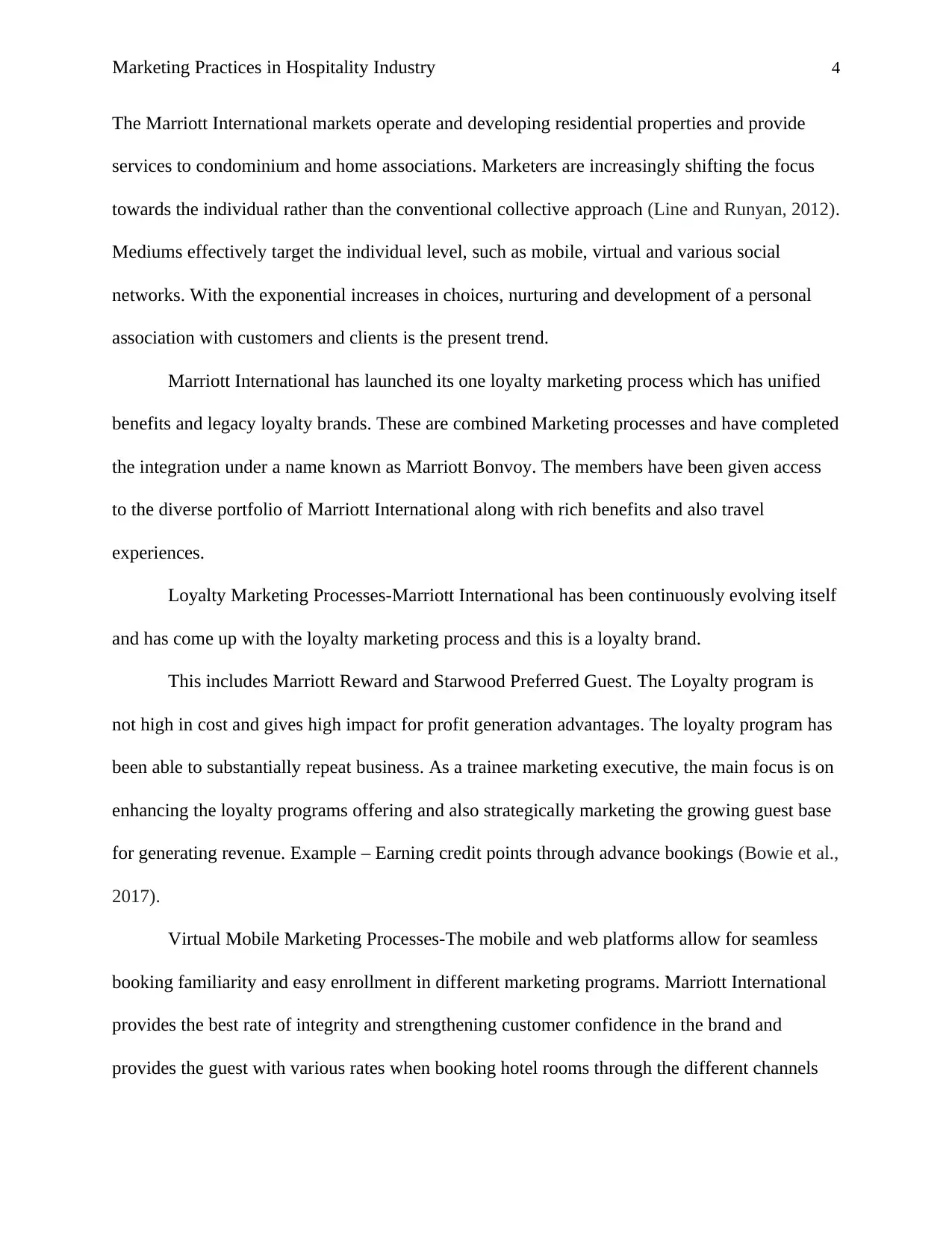
Marketing Practices in Hospitality Industry 4
The Marriott International markets operate and developing residential properties and provide
services to condominium and home associations. Marketers are increasingly shifting the focus
towards the individual rather than the conventional collective approach (Line and Runyan, 2012).
Mediums effectively target the individual level, such as mobile, virtual and various social
networks. With the exponential increases in choices, nurturing and development of a personal
association with customers and clients is the present trend.
Marriott International has launched its one loyalty marketing process which has unified
benefits and legacy loyalty brands. These are combined Marketing processes and have completed
the integration under a name known as Marriott Bonvoy. The members have been given access
to the diverse portfolio of Marriott International along with rich benefits and also travel
experiences.
Loyalty Marketing Processes-Marriott International has been continuously evolving itself
and has come up with the loyalty marketing process and this is a loyalty brand.
This includes Marriott Reward and Starwood Preferred Guest. The Loyalty program is
not high in cost and gives high impact for profit generation advantages. The loyalty program has
been able to substantially repeat business. As a trainee marketing executive, the main focus is on
enhancing the loyalty programs offering and also strategically marketing the growing guest base
for generating revenue. Example – Earning credit points through advance bookings (Bowie et al.,
2017).
Virtual Mobile Marketing Processes-The mobile and web platforms allow for seamless
booking familiarity and easy enrollment in different marketing programs. Marriott International
provides the best rate of integrity and strengthening customer confidence in the brand and
provides the guest with various rates when booking hotel rooms through the different channels
The Marriott International markets operate and developing residential properties and provide
services to condominium and home associations. Marketers are increasingly shifting the focus
towards the individual rather than the conventional collective approach (Line and Runyan, 2012).
Mediums effectively target the individual level, such as mobile, virtual and various social
networks. With the exponential increases in choices, nurturing and development of a personal
association with customers and clients is the present trend.
Marriott International has launched its one loyalty marketing process which has unified
benefits and legacy loyalty brands. These are combined Marketing processes and have completed
the integration under a name known as Marriott Bonvoy. The members have been given access
to the diverse portfolio of Marriott International along with rich benefits and also travel
experiences.
Loyalty Marketing Processes-Marriott International has been continuously evolving itself
and has come up with the loyalty marketing process and this is a loyalty brand.
This includes Marriott Reward and Starwood Preferred Guest. The Loyalty program is
not high in cost and gives high impact for profit generation advantages. The loyalty program has
been able to substantially repeat business. As a trainee marketing executive, the main focus is on
enhancing the loyalty programs offering and also strategically marketing the growing guest base
for generating revenue. Example – Earning credit points through advance bookings (Bowie et al.,
2017).
Virtual Mobile Marketing Processes-The mobile and web platforms allow for seamless
booking familiarity and easy enrollment in different marketing programs. Marriott International
provides the best rate of integrity and strengthening customer confidence in the brand and
provides the guest with various rates when booking hotel rooms through the different channels
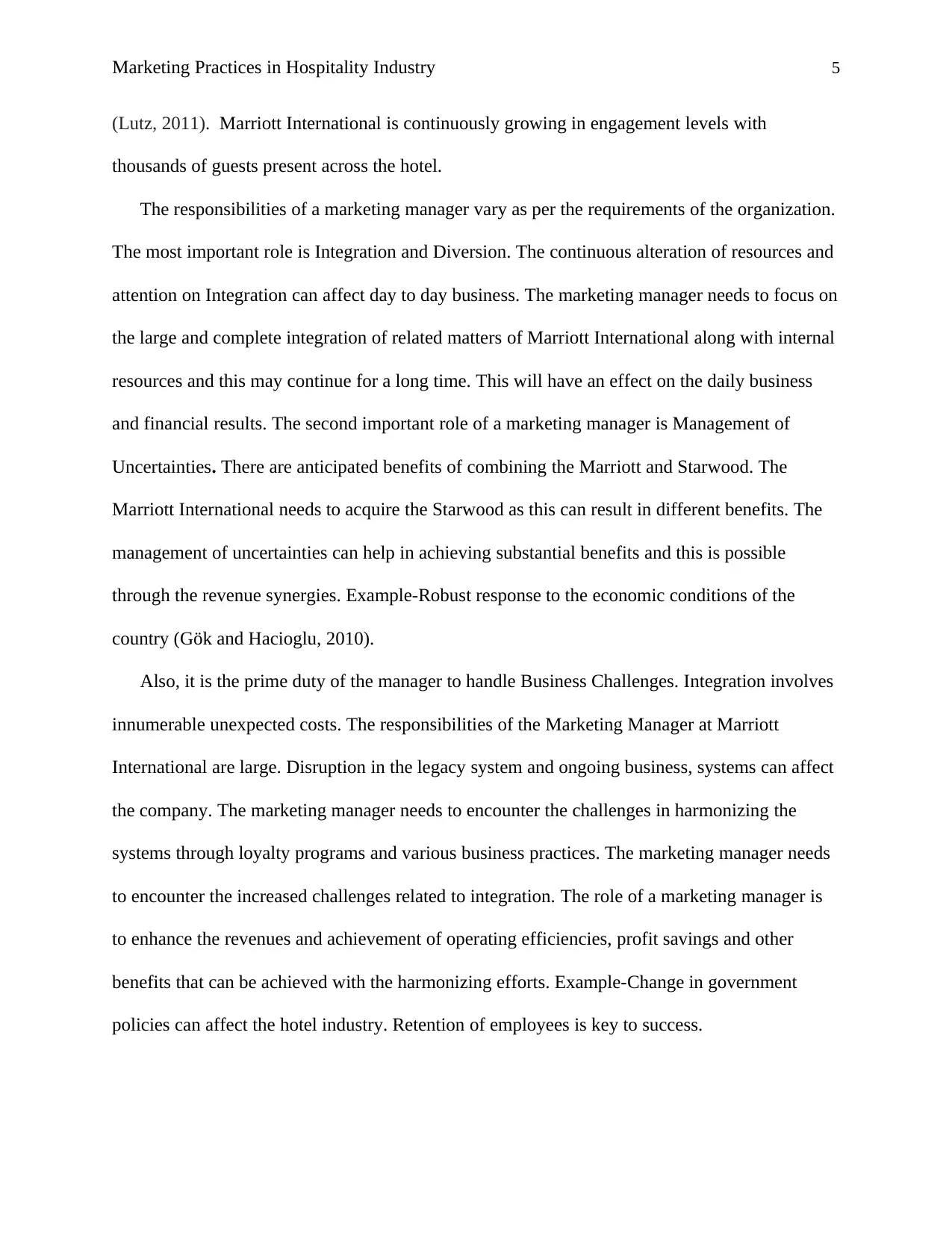
Marketing Practices in Hospitality Industry 5
(Lutz, 2011). Marriott International is continuously growing in engagement levels with
thousands of guests present across the hotel.
The responsibilities of a marketing manager vary as per the requirements of the organization.
The most important role is Integration and Diversion. The continuous alteration of resources and
attention on Integration can affect day to day business. The marketing manager needs to focus on
the large and complete integration of related matters of Marriott International along with internal
resources and this may continue for a long time. This will have an effect on the daily business
and financial results. The second important role of a marketing manager is Management of
Uncertainties. There are anticipated benefits of combining the Marriott and Starwood. The
Marriott International needs to acquire the Starwood as this can result in different benefits. The
management of uncertainties can help in achieving substantial benefits and this is possible
through the revenue synergies. Example-Robust response to the economic conditions of the
country (Gök and Hacioglu, 2010).
Also, it is the prime duty of the manager to handle Business Challenges. Integration involves
innumerable unexpected costs. The responsibilities of the Marketing Manager at Marriott
International are large. Disruption in the legacy system and ongoing business, systems can affect
the company. The marketing manager needs to encounter the challenges in harmonizing the
systems through loyalty programs and various business practices. The marketing manager needs
to encounter the increased challenges related to integration. The role of a marketing manager is
to enhance the revenues and achievement of operating efficiencies, profit savings and other
benefits that can be achieved with the harmonizing efforts. Example-Change in government
policies can affect the hotel industry. Retention of employees is key to success.
(Lutz, 2011). Marriott International is continuously growing in engagement levels with
thousands of guests present across the hotel.
The responsibilities of a marketing manager vary as per the requirements of the organization.
The most important role is Integration and Diversion. The continuous alteration of resources and
attention on Integration can affect day to day business. The marketing manager needs to focus on
the large and complete integration of related matters of Marriott International along with internal
resources and this may continue for a long time. This will have an effect on the daily business
and financial results. The second important role of a marketing manager is Management of
Uncertainties. There are anticipated benefits of combining the Marriott and Starwood. The
Marriott International needs to acquire the Starwood as this can result in different benefits. The
management of uncertainties can help in achieving substantial benefits and this is possible
through the revenue synergies. Example-Robust response to the economic conditions of the
country (Gök and Hacioglu, 2010).
Also, it is the prime duty of the manager to handle Business Challenges. Integration involves
innumerable unexpected costs. The responsibilities of the Marketing Manager at Marriott
International are large. Disruption in the legacy system and ongoing business, systems can affect
the company. The marketing manager needs to encounter the challenges in harmonizing the
systems through loyalty programs and various business practices. The marketing manager needs
to encounter the increased challenges related to integration. The role of a marketing manager is
to enhance the revenues and achievement of operating efficiencies, profit savings and other
benefits that can be achieved with the harmonizing efforts. Example-Change in government
policies can affect the hotel industry. Retention of employees is key to success.
⊘ This is a preview!⊘
Do you want full access?
Subscribe today to unlock all pages.

Trusted by 1+ million students worldwide
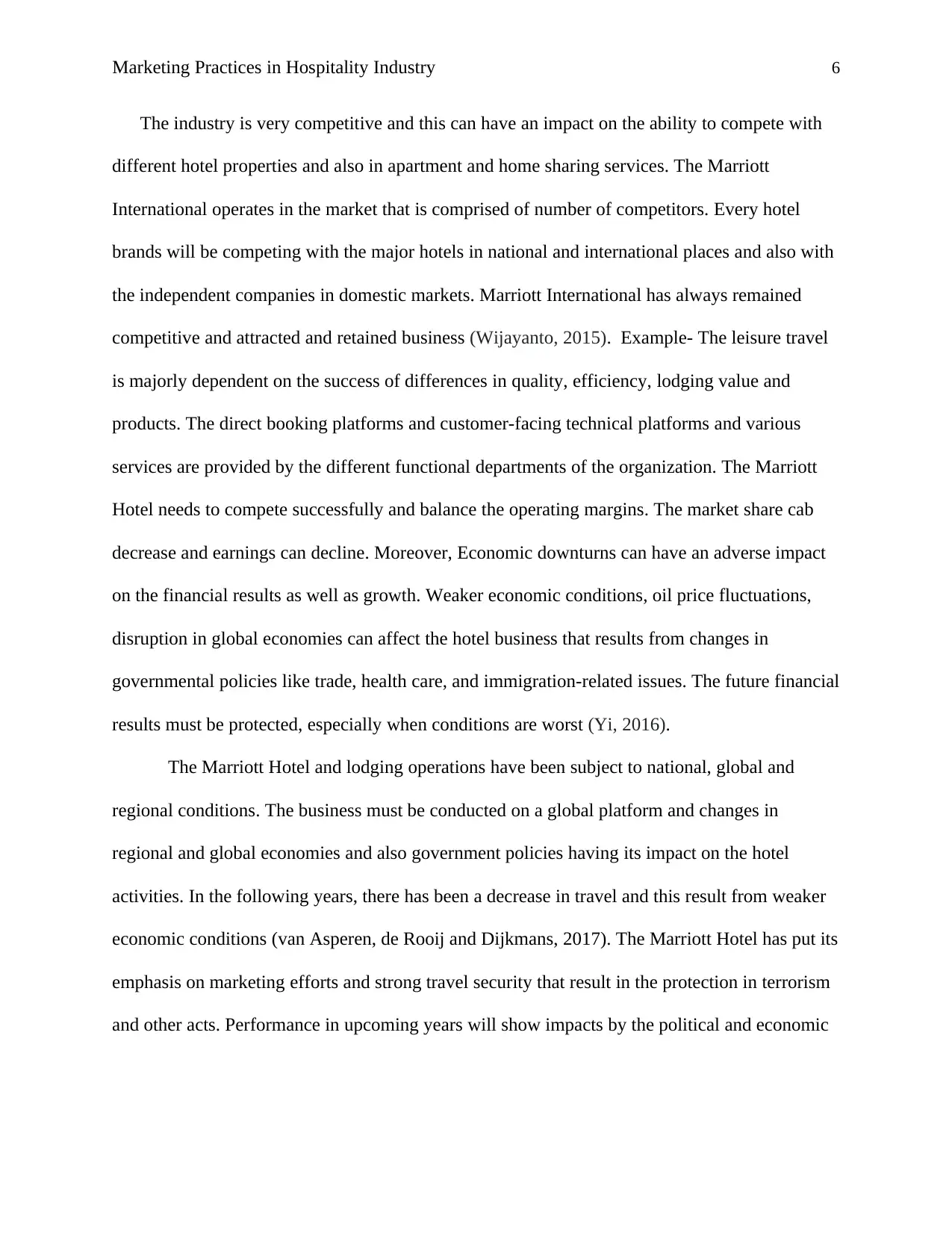
Marketing Practices in Hospitality Industry 6
The industry is very competitive and this can have an impact on the ability to compete with
different hotel properties and also in apartment and home sharing services. The Marriott
International operates in the market that is comprised of number of competitors. Every hotel
brands will be competing with the major hotels in national and international places and also with
the independent companies in domestic markets. Marriott International has always remained
competitive and attracted and retained business (Wijayanto, 2015). Example- The leisure travel
is majorly dependent on the success of differences in quality, efficiency, lodging value and
products. The direct booking platforms and customer-facing technical platforms and various
services are provided by the different functional departments of the organization. The Marriott
Hotel needs to compete successfully and balance the operating margins. The market share cab
decrease and earnings can decline. Moreover, Economic downturns can have an adverse impact
on the financial results as well as growth. Weaker economic conditions, oil price fluctuations,
disruption in global economies can affect the hotel business that results from changes in
governmental policies like trade, health care, and immigration-related issues. The future financial
results must be protected, especially when conditions are worst (Yi, 2016).
The Marriott Hotel and lodging operations have been subject to national, global and
regional conditions. The business must be conducted on a global platform and changes in
regional and global economies and also government policies having its impact on the hotel
activities. In the following years, there has been a decrease in travel and this result from weaker
economic conditions (van Asperen, de Rooij and Dijkmans, 2017). The Marriott Hotel has put its
emphasis on marketing efforts and strong travel security that result in the protection in terrorism
and other acts. Performance in upcoming years will show impacts by the political and economic
The industry is very competitive and this can have an impact on the ability to compete with
different hotel properties and also in apartment and home sharing services. The Marriott
International operates in the market that is comprised of number of competitors. Every hotel
brands will be competing with the major hotels in national and international places and also with
the independent companies in domestic markets. Marriott International has always remained
competitive and attracted and retained business (Wijayanto, 2015). Example- The leisure travel
is majorly dependent on the success of differences in quality, efficiency, lodging value and
products. The direct booking platforms and customer-facing technical platforms and various
services are provided by the different functional departments of the organization. The Marriott
Hotel needs to compete successfully and balance the operating margins. The market share cab
decrease and earnings can decline. Moreover, Economic downturns can have an adverse impact
on the financial results as well as growth. Weaker economic conditions, oil price fluctuations,
disruption in global economies can affect the hotel business that results from changes in
governmental policies like trade, health care, and immigration-related issues. The future financial
results must be protected, especially when conditions are worst (Yi, 2016).
The Marriott Hotel and lodging operations have been subject to national, global and
regional conditions. The business must be conducted on a global platform and changes in
regional and global economies and also government policies having its impact on the hotel
activities. In the following years, there has been a decrease in travel and this result from weaker
economic conditions (van Asperen, de Rooij and Dijkmans, 2017). The Marriott Hotel has put its
emphasis on marketing efforts and strong travel security that result in the protection in terrorism
and other acts. Performance in upcoming years will show impacts by the political and economic
Paraphrase This Document
Need a fresh take? Get an instant paraphrase of this document with our AI Paraphraser
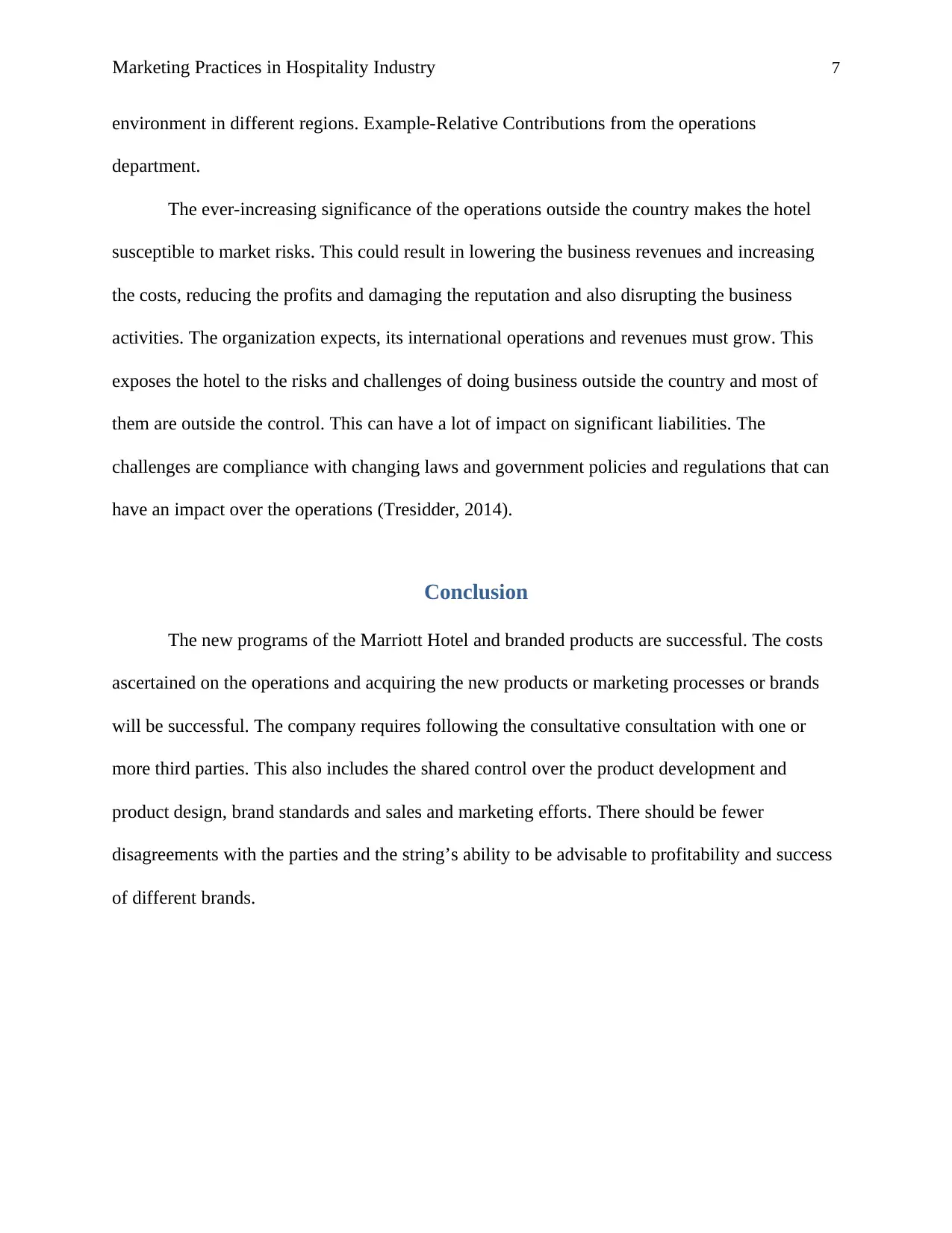
Marketing Practices in Hospitality Industry 7
environment in different regions. Example-Relative Contributions from the operations
department.
The ever-increasing significance of the operations outside the country makes the hotel
susceptible to market risks. This could result in lowering the business revenues and increasing
the costs, reducing the profits and damaging the reputation and also disrupting the business
activities. The organization expects, its international operations and revenues must grow. This
exposes the hotel to the risks and challenges of doing business outside the country and most of
them are outside the control. This can have a lot of impact on significant liabilities. The
challenges are compliance with changing laws and government policies and regulations that can
have an impact over the operations (Tresidder, 2014).
Conclusion
The new programs of the Marriott Hotel and branded products are successful. The costs
ascertained on the operations and acquiring the new products or marketing processes or brands
will be successful. The company requires following the consultative consultation with one or
more third parties. This also includes the shared control over the product development and
product design, brand standards and sales and marketing efforts. There should be fewer
disagreements with the parties and the string’s ability to be advisable to profitability and success
of different brands.
environment in different regions. Example-Relative Contributions from the operations
department.
The ever-increasing significance of the operations outside the country makes the hotel
susceptible to market risks. This could result in lowering the business revenues and increasing
the costs, reducing the profits and damaging the reputation and also disrupting the business
activities. The organization expects, its international operations and revenues must grow. This
exposes the hotel to the risks and challenges of doing business outside the country and most of
them are outside the control. This can have a lot of impact on significant liabilities. The
challenges are compliance with changing laws and government policies and regulations that can
have an impact over the operations (Tresidder, 2014).
Conclusion
The new programs of the Marriott Hotel and branded products are successful. The costs
ascertained on the operations and acquiring the new products or marketing processes or brands
will be successful. The company requires following the consultative consultation with one or
more third parties. This also includes the shared control over the product development and
product design, brand standards and sales and marketing efforts. There should be fewer
disagreements with the parties and the string’s ability to be advisable to profitability and success
of different brands.
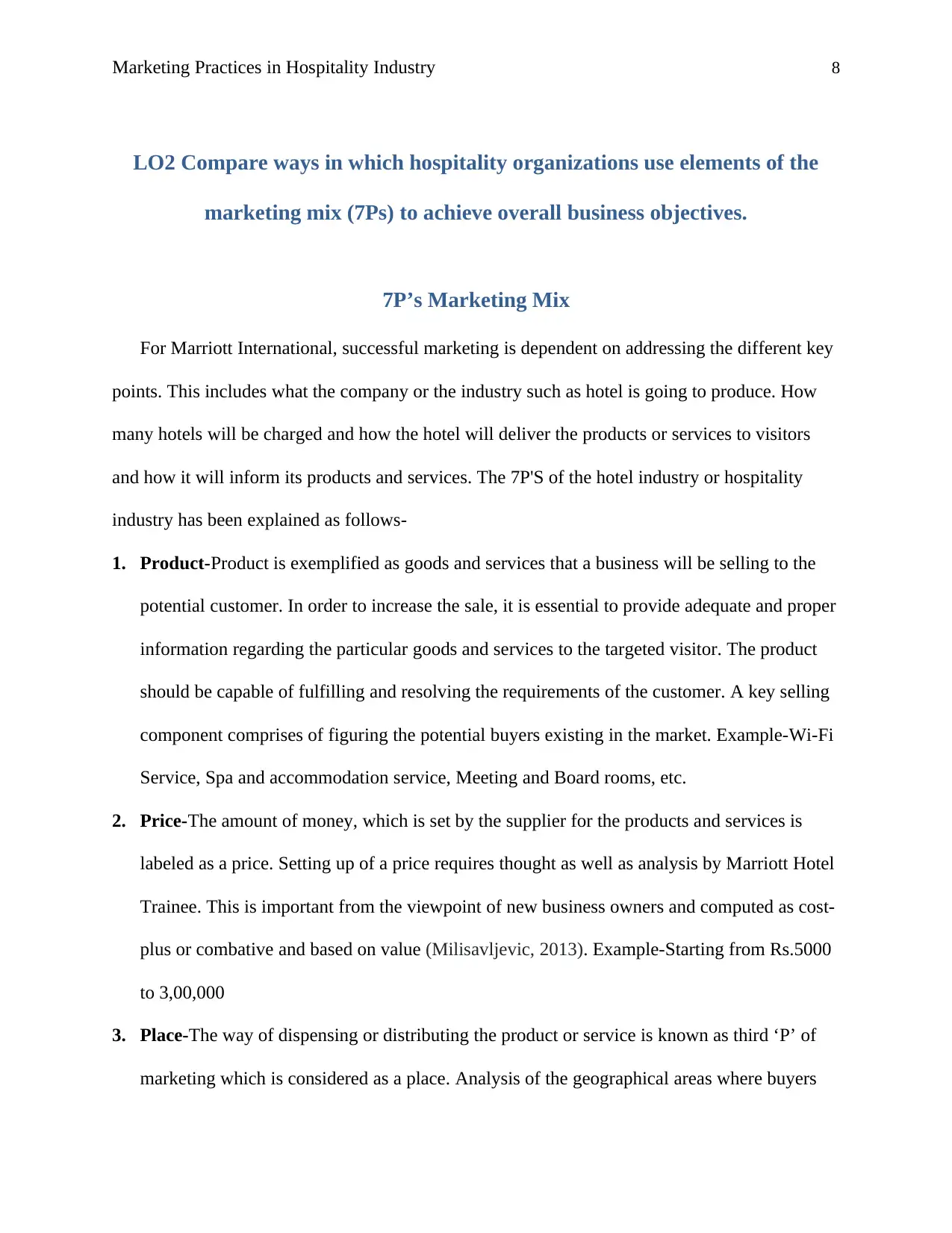
Marketing Practices in Hospitality Industry 8
LO2 Compare ways in which hospitality organizations use elements of the
marketing mix (7Ps) to achieve overall business objectives.
7P’s Marketing Mix
For Marriott International, successful marketing is dependent on addressing the different key
points. This includes what the company or the industry such as hotel is going to produce. How
many hotels will be charged and how the hotel will deliver the products or services to visitors
and how it will inform its products and services. The 7P'S of the hotel industry or hospitality
industry has been explained as follows-
1. Product-Product is exemplified as goods and services that a business will be selling to the
potential customer. In order to increase the sale, it is essential to provide adequate and proper
information regarding the particular goods and services to the targeted visitor. The product
should be capable of fulfilling and resolving the requirements of the customer. A key selling
component comprises of figuring the potential buyers existing in the market. Example-Wi-Fi
Service, Spa and accommodation service, Meeting and Board rooms, etc.
2. Price-The amount of money, which is set by the supplier for the products and services is
labeled as a price. Setting up of a price requires thought as well as analysis by Marriott Hotel
Trainee. This is important from the viewpoint of new business owners and computed as cost-
plus or combative and based on value (Milisavljevic, 2013). Example-Starting from Rs.5000
to 3,00,000
3. Place-The way of dispensing or distributing the product or service is known as third ‘P’ of
marketing which is considered as a place. Analysis of the geographical areas where buyers
LO2 Compare ways in which hospitality organizations use elements of the
marketing mix (7Ps) to achieve overall business objectives.
7P’s Marketing Mix
For Marriott International, successful marketing is dependent on addressing the different key
points. This includes what the company or the industry such as hotel is going to produce. How
many hotels will be charged and how the hotel will deliver the products or services to visitors
and how it will inform its products and services. The 7P'S of the hotel industry or hospitality
industry has been explained as follows-
1. Product-Product is exemplified as goods and services that a business will be selling to the
potential customer. In order to increase the sale, it is essential to provide adequate and proper
information regarding the particular goods and services to the targeted visitor. The product
should be capable of fulfilling and resolving the requirements of the customer. A key selling
component comprises of figuring the potential buyers existing in the market. Example-Wi-Fi
Service, Spa and accommodation service, Meeting and Board rooms, etc.
2. Price-The amount of money, which is set by the supplier for the products and services is
labeled as a price. Setting up of a price requires thought as well as analysis by Marriott Hotel
Trainee. This is important from the viewpoint of new business owners and computed as cost-
plus or combative and based on value (Milisavljevic, 2013). Example-Starting from Rs.5000
to 3,00,000
3. Place-The way of dispensing or distributing the product or service is known as third ‘P’ of
marketing which is considered as a place. Analysis of the geographical areas where buyers
⊘ This is a preview!⊘
Do you want full access?
Subscribe today to unlock all pages.

Trusted by 1+ million students worldwide
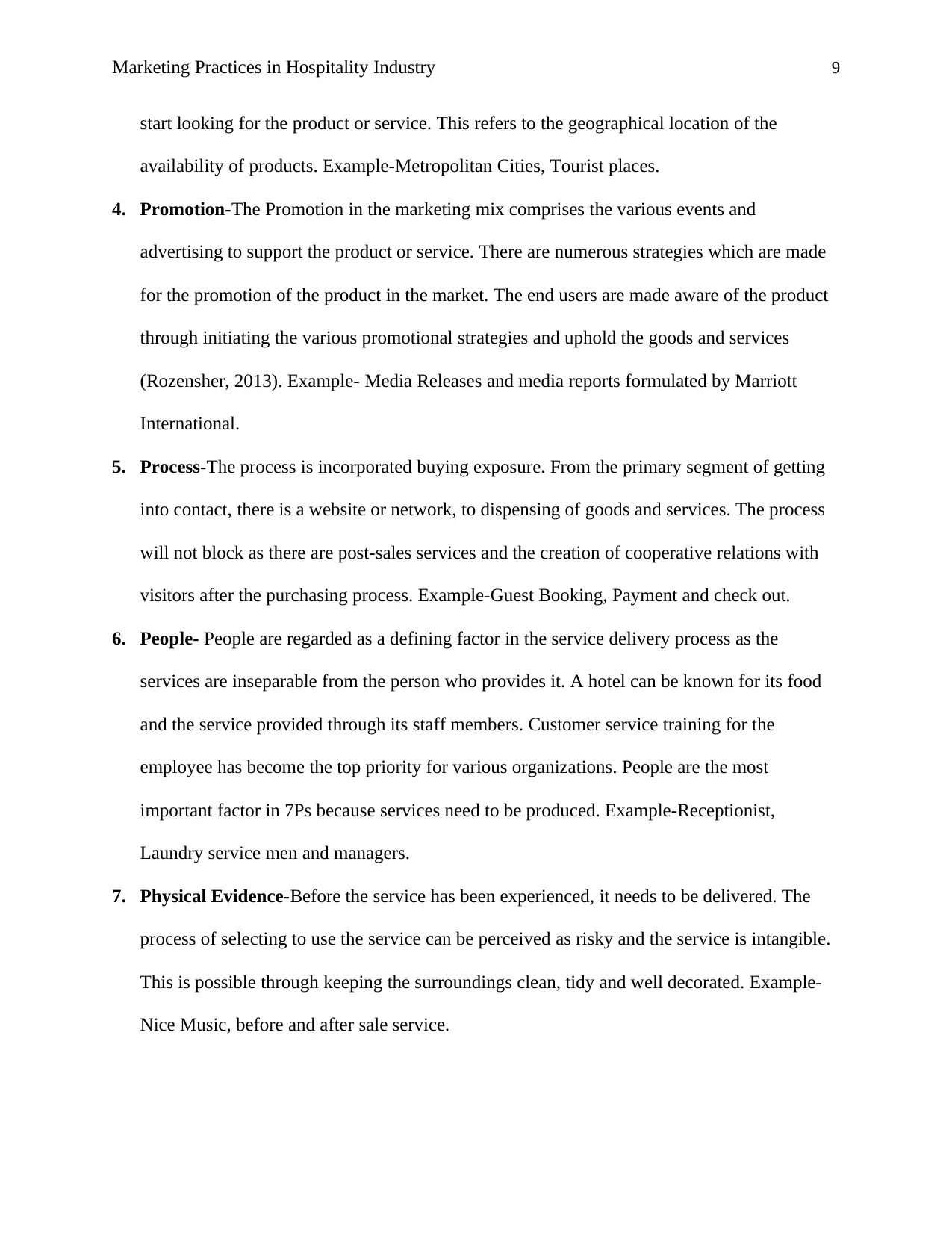
Marketing Practices in Hospitality Industry 9
start looking for the product or service. This refers to the geographical location of the
availability of products. Example-Metropolitan Cities, Tourist places.
4. Promotion-The Promotion in the marketing mix comprises the various events and
advertising to support the product or service. There are numerous strategies which are made
for the promotion of the product in the market. The end users are made aware of the product
through initiating the various promotional strategies and uphold the goods and services
(Rozensher, 2013). Example- Media Releases and media reports formulated by Marriott
International.
5. Process-The process is incorporated buying exposure. From the primary segment of getting
into contact, there is a website or network, to dispensing of goods and services. The process
will not block as there are post-sales services and the creation of cooperative relations with
visitors after the purchasing process. Example-Guest Booking, Payment and check out.
6. People- People are regarded as a defining factor in the service delivery process as the
services are inseparable from the person who provides it. A hotel can be known for its food
and the service provided through its staff members. Customer service training for the
employee has become the top priority for various organizations. People are the most
important factor in 7Ps because services need to be produced. Example-Receptionist,
Laundry service men and managers.
7. Physical Evidence-Before the service has been experienced, it needs to be delivered. The
process of selecting to use the service can be perceived as risky and the service is intangible.
This is possible through keeping the surroundings clean, tidy and well decorated. Example-
Nice Music, before and after sale service.
start looking for the product or service. This refers to the geographical location of the
availability of products. Example-Metropolitan Cities, Tourist places.
4. Promotion-The Promotion in the marketing mix comprises the various events and
advertising to support the product or service. There are numerous strategies which are made
for the promotion of the product in the market. The end users are made aware of the product
through initiating the various promotional strategies and uphold the goods and services
(Rozensher, 2013). Example- Media Releases and media reports formulated by Marriott
International.
5. Process-The process is incorporated buying exposure. From the primary segment of getting
into contact, there is a website or network, to dispensing of goods and services. The process
will not block as there are post-sales services and the creation of cooperative relations with
visitors after the purchasing process. Example-Guest Booking, Payment and check out.
6. People- People are regarded as a defining factor in the service delivery process as the
services are inseparable from the person who provides it. A hotel can be known for its food
and the service provided through its staff members. Customer service training for the
employee has become the top priority for various organizations. People are the most
important factor in 7Ps because services need to be produced. Example-Receptionist,
Laundry service men and managers.
7. Physical Evidence-Before the service has been experienced, it needs to be delivered. The
process of selecting to use the service can be perceived as risky and the service is intangible.
This is possible through keeping the surroundings clean, tidy and well decorated. Example-
Nice Music, before and after sale service.
Paraphrase This Document
Need a fresh take? Get an instant paraphrase of this document with our AI Paraphraser
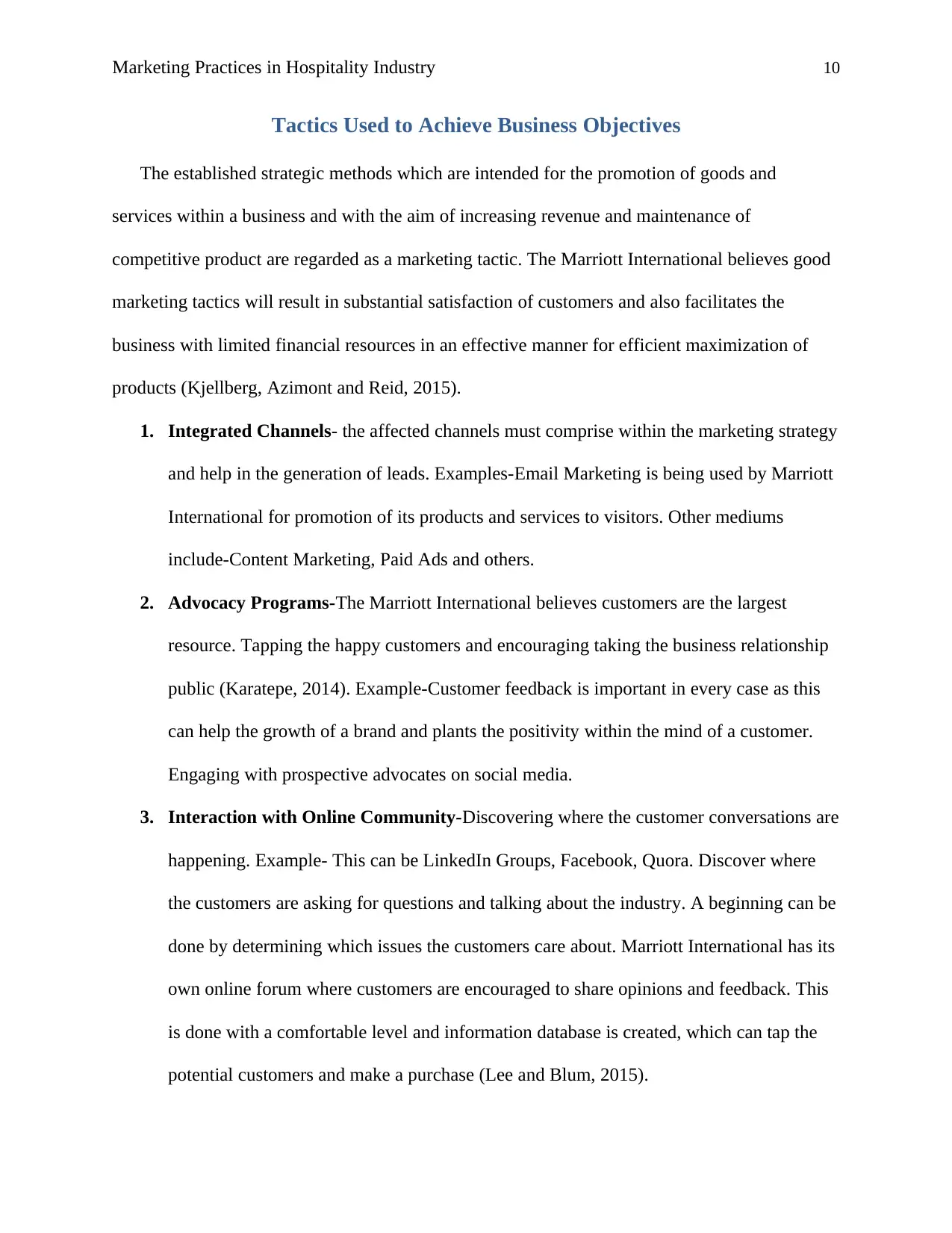
Marketing Practices in Hospitality Industry 10
Tactics Used to Achieve Business Objectives
The established strategic methods which are intended for the promotion of goods and
services within a business and with the aim of increasing revenue and maintenance of
competitive product are regarded as a marketing tactic. The Marriott International believes good
marketing tactics will result in substantial satisfaction of customers and also facilitates the
business with limited financial resources in an effective manner for efficient maximization of
products (Kjellberg, Azimont and Reid, 2015).
1. Integrated Channels- the affected channels must comprise within the marketing strategy
and help in the generation of leads. Examples-Email Marketing is being used by Marriott
International for promotion of its products and services to visitors. Other mediums
include-Content Marketing, Paid Ads and others.
2. Advocacy Programs-The Marriott International believes customers are the largest
resource. Tapping the happy customers and encouraging taking the business relationship
public (Karatepe, 2014). Example-Customer feedback is important in every case as this
can help the growth of a brand and plants the positivity within the mind of a customer.
Engaging with prospective advocates on social media.
3. Interaction with Online Community-Discovering where the customer conversations are
happening. Example- This can be LinkedIn Groups, Facebook, Quora. Discover where
the customers are asking for questions and talking about the industry. A beginning can be
done by determining which issues the customers care about. Marriott International has its
own online forum where customers are encouraged to share opinions and feedback. This
is done with a comfortable level and information database is created, which can tap the
potential customers and make a purchase (Lee and Blum, 2015).
Tactics Used to Achieve Business Objectives
The established strategic methods which are intended for the promotion of goods and
services within a business and with the aim of increasing revenue and maintenance of
competitive product are regarded as a marketing tactic. The Marriott International believes good
marketing tactics will result in substantial satisfaction of customers and also facilitates the
business with limited financial resources in an effective manner for efficient maximization of
products (Kjellberg, Azimont and Reid, 2015).
1. Integrated Channels- the affected channels must comprise within the marketing strategy
and help in the generation of leads. Examples-Email Marketing is being used by Marriott
International for promotion of its products and services to visitors. Other mediums
include-Content Marketing, Paid Ads and others.
2. Advocacy Programs-The Marriott International believes customers are the largest
resource. Tapping the happy customers and encouraging taking the business relationship
public (Karatepe, 2014). Example-Customer feedback is important in every case as this
can help the growth of a brand and plants the positivity within the mind of a customer.
Engaging with prospective advocates on social media.
3. Interaction with Online Community-Discovering where the customer conversations are
happening. Example- This can be LinkedIn Groups, Facebook, Quora. Discover where
the customers are asking for questions and talking about the industry. A beginning can be
done by determining which issues the customers care about. Marriott International has its
own online forum where customers are encouraged to share opinions and feedback. This
is done with a comfortable level and information database is created, which can tap the
potential customers and make a purchase (Lee and Blum, 2015).
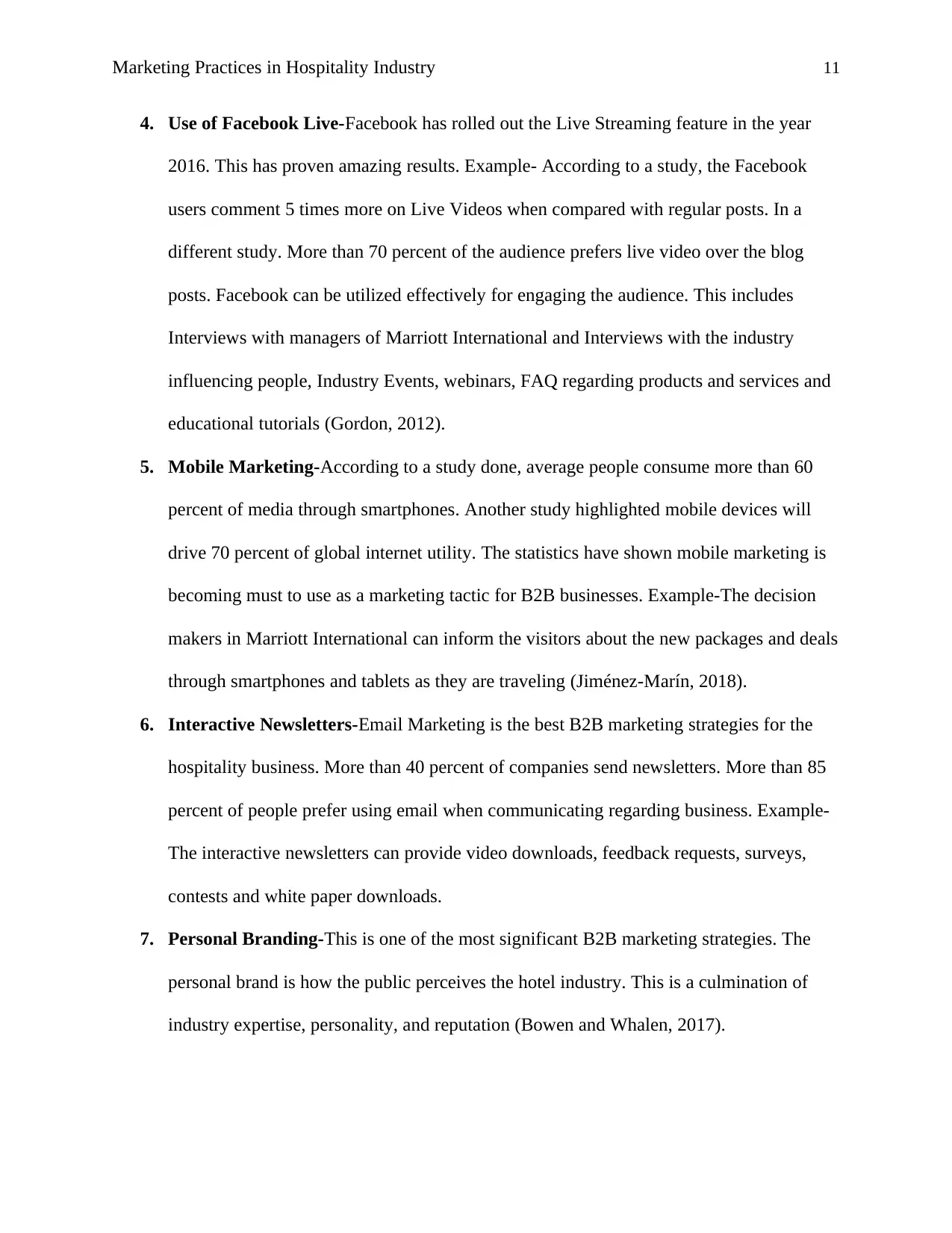
Marketing Practices in Hospitality Industry 11
4. Use of Facebook Live-Facebook has rolled out the Live Streaming feature in the year
2016. This has proven amazing results. Example- According to a study, the Facebook
users comment 5 times more on Live Videos when compared with regular posts. In a
different study. More than 70 percent of the audience prefers live video over the blog
posts. Facebook can be utilized effectively for engaging the audience. This includes
Interviews with managers of Marriott International and Interviews with the industry
influencing people, Industry Events, webinars, FAQ regarding products and services and
educational tutorials (Gordon, 2012).
5. Mobile Marketing-According to a study done, average people consume more than 60
percent of media through smartphones. Another study highlighted mobile devices will
drive 70 percent of global internet utility. The statistics have shown mobile marketing is
becoming must to use as a marketing tactic for B2B businesses. Example-The decision
makers in Marriott International can inform the visitors about the new packages and deals
through smartphones and tablets as they are traveling (Jiménez-Marín, 2018).
6. Interactive Newsletters-Email Marketing is the best B2B marketing strategies for the
hospitality business. More than 40 percent of companies send newsletters. More than 85
percent of people prefer using email when communicating regarding business. Example-
The interactive newsletters can provide video downloads, feedback requests, surveys,
contests and white paper downloads.
7. Personal Branding-This is one of the most significant B2B marketing strategies. The
personal brand is how the public perceives the hotel industry. This is a culmination of
industry expertise, personality, and reputation (Bowen and Whalen, 2017).
4. Use of Facebook Live-Facebook has rolled out the Live Streaming feature in the year
2016. This has proven amazing results. Example- According to a study, the Facebook
users comment 5 times more on Live Videos when compared with regular posts. In a
different study. More than 70 percent of the audience prefers live video over the blog
posts. Facebook can be utilized effectively for engaging the audience. This includes
Interviews with managers of Marriott International and Interviews with the industry
influencing people, Industry Events, webinars, FAQ regarding products and services and
educational tutorials (Gordon, 2012).
5. Mobile Marketing-According to a study done, average people consume more than 60
percent of media through smartphones. Another study highlighted mobile devices will
drive 70 percent of global internet utility. The statistics have shown mobile marketing is
becoming must to use as a marketing tactic for B2B businesses. Example-The decision
makers in Marriott International can inform the visitors about the new packages and deals
through smartphones and tablets as they are traveling (Jiménez-Marín, 2018).
6. Interactive Newsletters-Email Marketing is the best B2B marketing strategies for the
hospitality business. More than 40 percent of companies send newsletters. More than 85
percent of people prefer using email when communicating regarding business. Example-
The interactive newsletters can provide video downloads, feedback requests, surveys,
contests and white paper downloads.
7. Personal Branding-This is one of the most significant B2B marketing strategies. The
personal brand is how the public perceives the hotel industry. This is a culmination of
industry expertise, personality, and reputation (Bowen and Whalen, 2017).
⊘ This is a preview!⊘
Do you want full access?
Subscribe today to unlock all pages.

Trusted by 1+ million students worldwide
1 out of 21
Related Documents
Your All-in-One AI-Powered Toolkit for Academic Success.
+13062052269
info@desklib.com
Available 24*7 on WhatsApp / Email
![[object Object]](/_next/static/media/star-bottom.7253800d.svg)
Unlock your academic potential
Copyright © 2020–2025 A2Z Services. All Rights Reserved. Developed and managed by ZUCOL.




